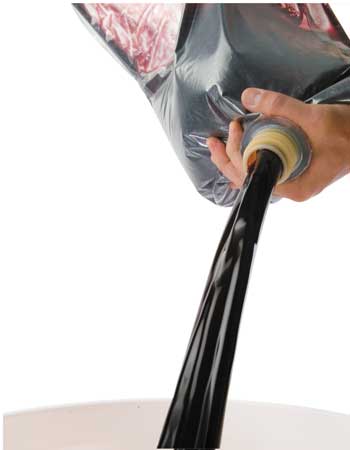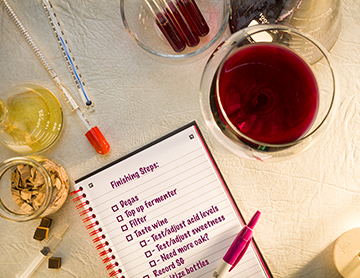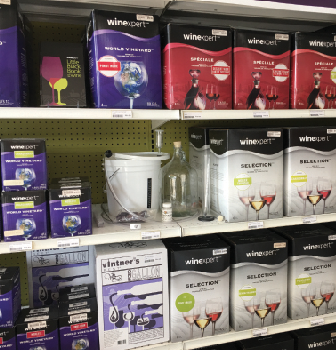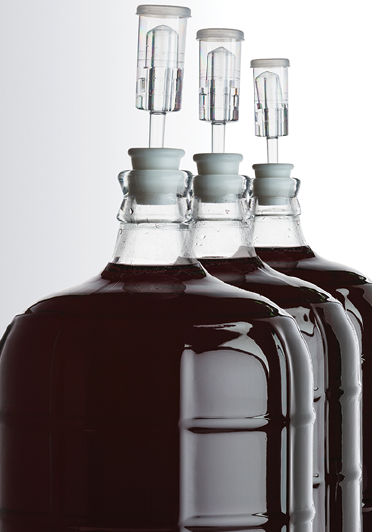Table Wine Kits
This article we’ll be discussing immediate and intermediate strategies for making table wines that can be consumed very young while still delivering the full and delightful wine experience.
Strategy one: go cheap — but not too cheap
Value-priced wine kits, which are usually smaller-sized (two to three US-gallons/7.5-11-L in the box), are inexpensive because they come from less defined wine regions than the bigger kits, and tend to contain a bit more concentrate.
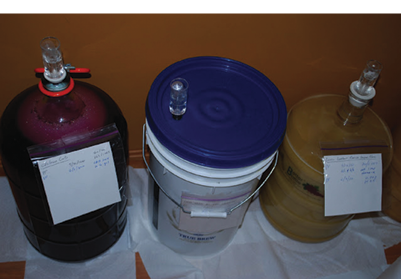
As viticultural areas get more desirable the grapes grown there fetch higher prices and the land values rise steeply. After a certain point the land becomes so expensive the grapes must fetch high prices to pay for new vineyard acquisition and things like taxes, mortgages
and services.
Also, concentrate, by virtue of shipping and storing advantages (it occupies one-half to one-fifth the volume of fresh juice and doesn’t require refrigeration to last extended times in storage) is generally less expensive to use in kits — although manufacturers are sensitive to saying so.
Now as to why manufacturer’s hate mentioning this in public: concentrate isn’t necessarily lower in quality — there’s concentrate and there’s concentrate, and the bespoke, low-density stuff can be as expensive (pre volume of finished wine) as some single-vineyard juices. Also, there are very inexpensive juices that are of lower quality than well-made concentrate. So it’s agony to a marketer or salesperson to try to manage the nuance of concentrate use for consumers. It always sounds like you want it both ways.
However, the bottom line is that the smaller kits generally have more concentrate, which overall has less TDS (total dissolved solids) than fresh juices generally do, they drink faster when young (more TDS means more stuff that needs to calm down after fermentation, and a longer timeline before drinking).
There is a pretty severe line of diminishing returns: super-cheap kits, while serving a necessary and useful role in consumer winemaking (e.g. feeding to brother-in-laws, Sangria, etc.) may drink as well young as they do after age, but in the long run that may not be saying much. As the Spanish observe, “Cheap wine ruins the stomach: expensive wine ruins the purse.”
Don’t use the most expensive kit you can find to make young-drinking wine, nor the cheapest — use your dollars wisely and you’ll get the best results.
Strategy two: choose the right wines
Once you’ve picked your kit price point it’s time to choose the varietals and styles that are going to gratify most quickly. Varietal is (of course) the specific type of grape used to make a kit. Style can either be a kit manufacturer’s emulation of a regional specialty from one of the countries they source juice from, or it can be more general: dessert, fortified, sparkling, etc.
Dessert and fortified wines
Icewine-style, Sherry-style and Port (regular or flavored with chocolate and additional fruits) are lusciously sweet, potent wines. They’re not daily drinkers unless you’re living life on the edge of hypoglycemia, but they are immensely satisfying in the right context, as an aperitif, with (or as) dessert, or for quiet contemplation in an easy chair surrounded by friends.
This category of wine is usually quite sweet. In the case of Icewine-style it can be a 20 in sweetness on a scale of 1 to 10. Sugar is a youthful drinker’s best friend. Sweet things taste inherently good to us, and sugar covers up a host of green, young flavors, making the wines taste fantastic right out of the carboy. Sure, they’ll develop over time, but the journey towards full maturity is littered with great opportunities for enjoyment. Icewine is quite zesty, despite the high sugar, giving it good balance with sweet desserts or cheeses, while Sherry is mellower, with notes of caramel and nuts.
Flavored Port-styles are especially good for early drinking. When they are quite young they are usually dominated by the added flavor, be it chocolate essence and chocolate liquor or natural fruit flavors. As they age they get more “Porty,” focusing on the grape side of the flavor profile, giving them a multi-faceted drinking experience.
Sparkle plenty
Fizz is a brilliant leveller of wacky, uncoordinated wines. Traditional French Champagne is made from grapes that simply couldn’t make decent table wine otherwise. If you find that hard to believe, open a bottle of Champagne sometime, degas a glassful completely and try drinking it against any other white table wine. It can be thin, and sour to the point of harshness. It’s often full of crusty, yeasty flavors that any home winemaker would count as a serious flaw in their own wine.
The secret is the mouthfeel from carbon dioxide: the bubbles on your tongue confuse your tastebuds giving a weight and foamy smoothness to the wine that forgives all. In addition, carbon dioxide gas in solution produces carbonic acid, which flattens harsh flavors making fizzy wine a tasty, lively beverage that requires almost no aging to be delightfully drinkable.
The varietals: whites
It may come as a surprise to most people, but I feel that Chardonnay is a wine that is probably best while still young. It’s very much a chameleon of the vineyard, taking more on from how it’s grown, and the élevage (post-fermentation techniques) used on it than from any varietal character.
This applies both to the big, buttery, heavily-oaked style as well as the leaner, crisper, unoaked-style that has become more popular in recent years. Softly rounded and layered with vanilla, the big-oak style covers the palate like marshmallow syrup, going down smooth and easy, while the more minimalist expression of the unoaked gives generally uncomplicated white fruit notes and hints of either apples or tropical fruit, depending on how hot the climate it was grown in. All around, Chardonnay should be the go-to wine for those looking for an early drinker to make.
Sauvignon Blanc is another easy drinker. Tending heavily towards grassy/herbal notes and citrusy fruit, it’s almost like drinking tangy grapefruit juice when it’s young. Brash, uncomplicated and very up-front, it also works well with highly acidic foods (young Sauvignon Blanc and ceviche is a knockout). It can also be made in the Fumé Blanc style by fermenting it with oak. Just like Chardonnay, the oak smooths away the snappiest of the young acidic zinginess, making it drink even better right on bottling day.
Pinot Blanc almost splits the difference between Chardonnay and Sauvignon Blanc. With a berryish note that it gets from its close relation, Pinot Noir, it can have softer fruit and a bigger mouthfeel than either of those wines, but doesn’t need a year in the bottle to show off gentle flavors. Again, it can be more fruit-focused on its own, but oak always works its magic.
Viognier kits have become much more popular in the last five years. With aromas of blossoms and honeysuckle that almost recalls Juicy Fruit chewing gum and flavors of ripe peach and apricot, it also has a rich, heavy body that make it a true hedonists’ wine. Even the most expensive and exclusive Viogniers are intended to be drank very young, and kits are not an exception to this idea.
I mention Riesling last, but not because it’s least. It does present a conundrum for early consumers. It is the longest-aging white grape, with wines from the finest vineyards in Germany lasting more than a hundred years and even just good ones aging at the same rate as first-growth Bordeaux. Those wines, however, are the ones that grow in the finest areas, and ripen up to very high levels while retaining crackling acidity. Take a step down, and you find lower-alcohol wines that have their crisp, apple-y acidity balanced perfectly by a touch of residual sweetness. In general terms, because it is an early ripening grape, the flavors can be somewhat straightforward: white fruits, floral notes and a bit of stone fruit.
What goes for Riesling goes double for Müller-Thurgau, which has most of the floral and fruity notes of Riesling, with perhaps a bit more citrus and an easy and early drinkability.
The varietals: reds
Before red is rosé. A style awash in sub-styles, pink wine rarely gets the respect it deserves in Western wine thinking. White Zinfandel dominated the category for so many years that it steamrolled most other attempts to produce a serious-but-pleasurable alternative.
There’s nothing wrong at all with White Zin: no cellar would be complete without a wine that can be drank ice-cold with fried chicken or even over ice on a searingly hot day, and most of these wines have between 2 and 4% residual sugar and are as easy drinking as soda pop.
There are drier rosé wines available, usually seasonally from the kit companies. Generally drier than White Zin, they nevertheless deliver notes of crisp red fruit and berries with a zesty acidity and a tiny hint of tannin that makes them juicy and excellent for early drinking with a wide array of foods.
Merlot, ah, blessed Merlot. There is a truism among wine purveyors confronted with an unsure customer who is trying to choose a red wine: unless it’s going to clash with the food they’re ordering, give them a Merlot. With a velvety mouthfeel, soft, plummy notes and a finish that ranges from toasty oak to fruitcake, it’s the red answer to Chardonnay: few people don’t like it and many like it a lot. French and French-style Merlot tends to be a bit too austere for early drinking. Stick to the new world in general, and Chile in particular. Self-rooted vines give a more direct sense of Merlot’s fruit, and the sweetness that fully ripe Merlot makes it lovely for quick consumption.
We discussed Gamay, in the guise of Nouveau-style in the previous article, but it bears a repeat mention: even when not done a la vin Nouveau, standard Gamay can be lovely: far from the tart, light-crimson silliness of Nouveau, proper Gamay is almost like Pinot Noir’s sweet kid sister: vivacious, lively and smelling of red candies and cherries. It really doesn’t cellar well, but rather it drinks wonderfully well when young, and whatever it lacks in challenges to your palate, it makes up for in purely pleasurable, lightly tannic gulping.
Speaking of Pinot Noir, it’s a grape that carries its own mythology, sometimes like a millstone around its neck. Since the movie Sideways it’s almost become, as Jancis Robinson notes, “boringly mainstream” — a reflection of Merlot’s status and a weird turn of events for a grape that previously commanded devotion to the point of madness from its devotees.
Popular culture notwithstanding, Pinot can express gentle notes of raspberry and cherry and lean, refined tannins that don’t overwhelm the early drinker. Usually more ruby/garnet in color rather than purple-black, the generally lower-levels of tannin or heady fruit mean that while it does age just fine, it satisfies greatly when young, especially from New World regions, and in particular Chile, California and Australia, and matches milder cuts of red meat very well indeed.


